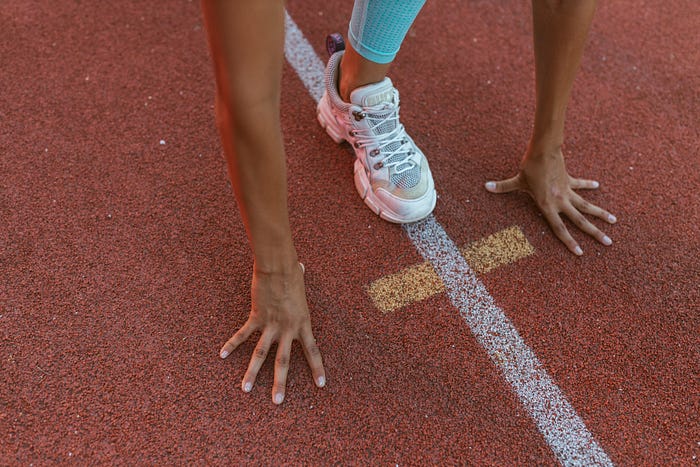Empowering Runners: A Comprehensive Approach to Plantar Fasciitis
Written on
Chapter 1: Understanding Plantar Fasciitis
Plantar fasciitis is a common yet often misinterpreted ailment among runners and the fitness community. Research indicates that this condition is less about inflammation and more akin to a tendinopathy. This suggests that we should engage these tissues in exercises designed to improve their tensile strength rather than opting for rest or heat/ice treatments. In essence, an active recovery approach is most beneficial for plantar fasciitis.
If you've been dealing with plantar fasciitis for an extended period, or are experiencing general discomfort in your foot or ankle, consider implementing the exercises outlined below. They can significantly expedite recovery and target often neglected tissues in runners. Enhancing the strength and functionality of one area can improve the health of tissues throughout the kinetic chain, making this strategy essential for any runner or athlete aiming to enhance foot health.
It's Time to Take Charge of Your Foot Health
Before we proceed, it's crucial to acknowledge that each case of plantar fasciitis is unique. If you experience significant pain or discomfort during any of the exercises, consult a qualified health professional. This program is designed to help most individuals, but some may need additional adjustments for optimal results.
Aim to perform this program at least 3 to 4 times a week. Ideally, doing it daily is even better. Consider integrating it into your routine before engaging in physical activity. As with most of my programs, strive to work within your maximum pain-free range and execute each movement slowly. Consistency is key; while the routine may not be the most exciting, its effectiveness is undeniable. By adhering to this program, you should notice significant improvements in the coming days and weeks. The exercises are arranged from 'least active' to 'most active,' so keep that in mind as you progress.
Now, let's get started.
Section 1.1: Kneeling Foot Stretch

Application: 5 x 10–20 seconds hold
Instructions: Begin on your knees with your toes tucked under. Ensure the big toes touch and the other toes are splayed evenly on the ground. Sit back onto your heels and hold this position for approximately 10 to 20 seconds. For added comfort, you may place a pillow underneath your buttocks or knees. If the stretch feels too intense, reduce the range of motion by elevating your hips slightly.
Section 1.2: Toe to Heel Walks
Application: 15–20 steps per side
Instructions: Alternate between walking on your heels (toes pointed upward) and on your toes. Maximize the ankle's range of motion in both positions. This exercise is also reputed to aid those dealing with shin splints. Additionally, it can enhance your balance!
Subsection 1.2.1: Toe Scrunches with Towel
Application: 5–6 repetitions per side
Instructions: Sit on a chair with your foot resting on a flat towel. Gradually curl your toes to bunch up the towel while keeping your heel stationary. After completing a rep, spread the towel out again and repeat. Focus on isolating this action to your foot, avoiding compensation from your leg. Aim for 5 to 6 repetitions per side, or until you feel significant fatigue in the foot muscles.
Chapter 2: Advanced Techniques for Foot Health
Section 2.1: Soleus-Focused Walking Lunges
Application: 6–8 repetitions per side
Instructions: This is the most advanced exercise on our list. Ensure you're comfortable with basic walking lunges before attempting this variation. For balance, perform the exercise near a wall or with a dowel for support. Start in a forward lunge position, then elevate your heel off the floor at the bottom. Hold this position for 1 to 2 seconds, then lower your heel back to the floor and return to a neutral standing position. Alternate legs as you move forward. While this may feel awkward at first, it effectively strengthens one of the foot's weakest positions and isolates the soleus muscle of the calf.
In Conclusion
Although plantar fasciitis can be debilitating for runners, nearly everyone can find relief through intelligent exercise. Loading the tissues of your foot will enhance strength and mobility, accelerating recovery and preventing further complications. Although progress may be gradual, stay committed to your routine and trust that you'll begin to feel like yourself again in due time. Let's focus on minimizing injury downtime and maximizing your running goals.
You've got this!
-David Liira, Kinesiologist
The first video titled "Runner's Guide to Plantar Fasciitis: Symptoms, Treatment, and Recovery Strategies" offers essential insights into managing this condition effectively.
The second video, "Fix Plantar Fasciitis for Good and Run! (5 Simple Actions)," provides practical steps to eliminate pain and enhance your running experience.